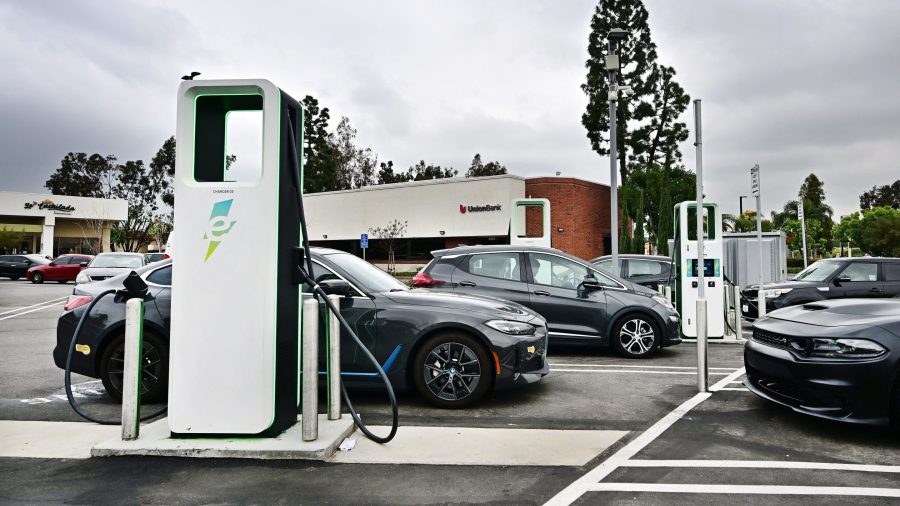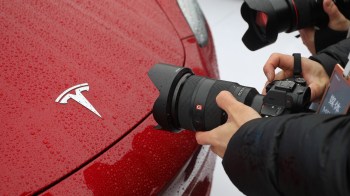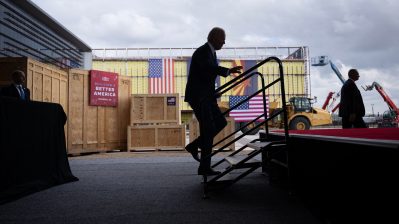Long lines and broken chargers: Demand for powering EVs outpaces infrastructure

More than a million electric vehicles were sold in the U.S. this year, but despite that, GM, Ford and Tesla announced they were reducing production of EVs in the fall.
As more drivers make the switch to electric, the availability of public places to juice up those cars hasn’t kept pace. In 2021, the federal government set aside $7.5 billion to build tens of thousands of chargers across the country. But the project has barely broken ground in the two years since.
Marketplace’s Lily Jamali spoke with Marketplace reporter Meghan McCarty Carino about the issue, which she’s been following as both a reporter and an EV driver. The owner of a 2019 electric Volkswagen Golf said relying on public charging has become more difficult as EVs have multiplied on the road and at the stations where they power up.
The following is an edited transcript of their conversation.
Meghan McCarty Carino: I have owned my EV since 2019. It’s kind of an older model, it’s a lower-range EV. This was the first year, I would say, I really started to question my decision to get an EV. There are a number of reasons, I think, but basically the charging situation became untenable.
Lily Jamali: I’m surprised by that because you’d think if you’d had it since 2019, the charging situation would have only gotten better. So, what’s going on?
McCarty Carino: As I have shared on the program before, I live in an apartment where I cannot charge the vehicle at home. I thought I would be able to when I bought the car, but the trickle charge from the outside outlet has not worked. So, I rely entirely on public chargers. And you would think, OK, there are more chargers going in and public charging should be getting better. But actually, I would say that we’ve sort of reached this tipping point where, yes, charging infrastructure is getting better, but it is so far behind where the vehicle sales are. I think we kind of have reached a turning point in terms of electric vehicle sales going a little bit more mainstream. So rather than only people who are wealthy and own their own homes buying expensive electric vehicles, I think there’s a much broader diversity of people buying electric vehicles now, in part because of some of the tax credits and things like that. But it’s putting a lot of pressure on the charging infrastructure, and it is not holding up.
Jamali: Tell me more about that. Are you having to wait in long lines? Or is the charging equipment broken?
McCarty Carino: All of the above. I have had multiple times where I go to a charging station, and I’ll wait an hour-plus to try to get a charger. And it’s usually because many of the chargers at the location are broken. There was a J.D. Power study earlier this year that suggested something like 20% of the stations that they studied were out of order. I would say in my experience living in Los Angeles, it’s a much higher percentage than that.
I’ve had situations where I have almost run out of charge because I’ve gone from charging station to charging station to charging station and just been unable to use the public charging stations and ended up finding a charger at an out-of-the-way location that was not a fast charger, sit in the car listening to podcasts for four hours near the Burbank airport.
Jamali: Four hours, for real? I can’t even fathom that. And I can completely understand now why you would say you’re regretting your decision to buy an EV.
McCarty Carino: Yeah, this is the first year that I have had multiple instances where I almost got stuck, where I almost ran out of charge away from home. The range anxiety thing is something I knew about when I bought the car, but the public charging infrastructure was working pretty well for me until this year and until it got so overloaded. The volume of people that are using public charging is so great, and the chargers are incurring a lot of wear and tear.
Jamali: The federal government had big plans to help EV owners like you by setting aside over $7 billion a few years ago as part of President Biden’s infrastructure bill, specifically to fund more public chargers. This effort has not gotten very far yet. Why is that?
McCarty Carino: I just saw a press release about the first charging stations funded by this program opening up in New York and Ohio just recently. The funds are going to states and they’re going to bid these projects out to private companies. So far, in early December, more than half of states haven’t even started taking bids for these projects. Federal programs often have a lot of requirements, they have kind of a long list of compliance things that companies have to do in order to qualify for these funds. And that slows the process down. There are certain requirements about the intervals with which the chargers have to be spaced along interstate highways. They have to have certain payment systems, they have to be in good repair a certain percentage of the time and have plans to deal with that, which in my experience would be a good thing. But you know, it does create some barriers to entry in addition to the normal sort of slow-moving bureaucratic processes through which these funds are being disbursed.
Jamali: If the federal government hasn’t solved this problem, who is?
McCarty Carino: You sometimes see businesses putting in chargers. In many cases, it’s local governments, local utility companies. And then often it’s just kind of this patchwork approach by these private companies that run the chargers, and that’s a really hard way to do this. It’s a hard business decision to make because there’s kind of this chicken-and-egg thing where companies don’t want to pay to install them if there’s not enough demand, but people aren’t going to buy more EVs until they feel like the charging infrastructure is more built out.
Jamali: Well, it sounds like they are buying more EVs and we’ve reached this breaking point that you’ve described.
McCarty Carino: Yeah, you know a lot of rental companies I noticed really went hard on EVs. I have met a lot of people who have rented an EV and are struggling at a charging station and really regretting their decision to rent an EV.
Jamali: It’s like their first taste of range anxiety. So I understand that you are actually shopping for a new EV. What are some of the things you’re thinking about as you go through that process?
McCarty Carino: I know. You may be surprised after this talk that I am still considering an EV, but I am still committed to the technology. I really liked the experience of driving an EV, I really don’t want to go back to buying gas and I think that ultimately it will work for my lifestyle if I can just get some of these finer details worked out.
So, the main thing that I’m definitely looking at is range. I went with a cheaper option when I bought the car and ranges were lower back then. So, I am going to look for one with a higher range, which is going to be easy because pretty much any car has a higher range than mine does.
Then secondly, the speed of charging. This is kind of a detail that sometimes gets overlooked, but even with cars with the same range, some vehicles are now capable of much, much faster charging. For instance, Hyundai vehicles can charge from zero to 80% at the top-performing fast chargers in 18 minutes, which is incredible. My car, which has a very low range, takes 45 minutes to add that much range back onto the battery. A number of automakers, I think it’s a dozen or more, are going to be switching to a system where they can use Tesla chargers. Next year, many of them will be able to use Tesla chargers with an adapter, and then further into the future, many of the automakers are going to be actually switching to add a Tesla charger on to the actual vehicle. Tesla, of course, has the largest network of fast chargers in the country. They just had a head start on adding chargers and because the carmaker actually invested in that as an important piece of the car-ownership picture. It’s a much better network, so I am hopeful to join it.
As Meghan recently reported on the “Marketplace Morning Report,” the calculus for buying an electric car got more complicated this month. Under new guidance from the Department of Energy, some popular EVs will no longer qualify for the $7,500 federal tax credit that had prompted so many people to buy. The Nissan Leaf, the Ford Mustang Mach-E and Tesla’s Model 3 are all on that list because too many of their components originate in China.
The change kicks in New Year’s Day. It’s left some buyers Meghan spoke to weighing not just the model, color and trim choices of their next vehicle, but also whether to buy now or wait until next year.
The future of this podcast starts with you.
Every day, the “Marketplace Tech” team demystifies the digital economy with stories that explore more than just Big Tech. We’re committed to covering topics that matter to you and the world around us, diving deep into how technology intersects with climate change, inequity, and disinformation.
As part of a nonprofit newsroom, we’re counting on listeners like you to keep this public service paywall-free and available to all.
Support “Marketplace Tech” in any amount today and become a partner in our mission.


















